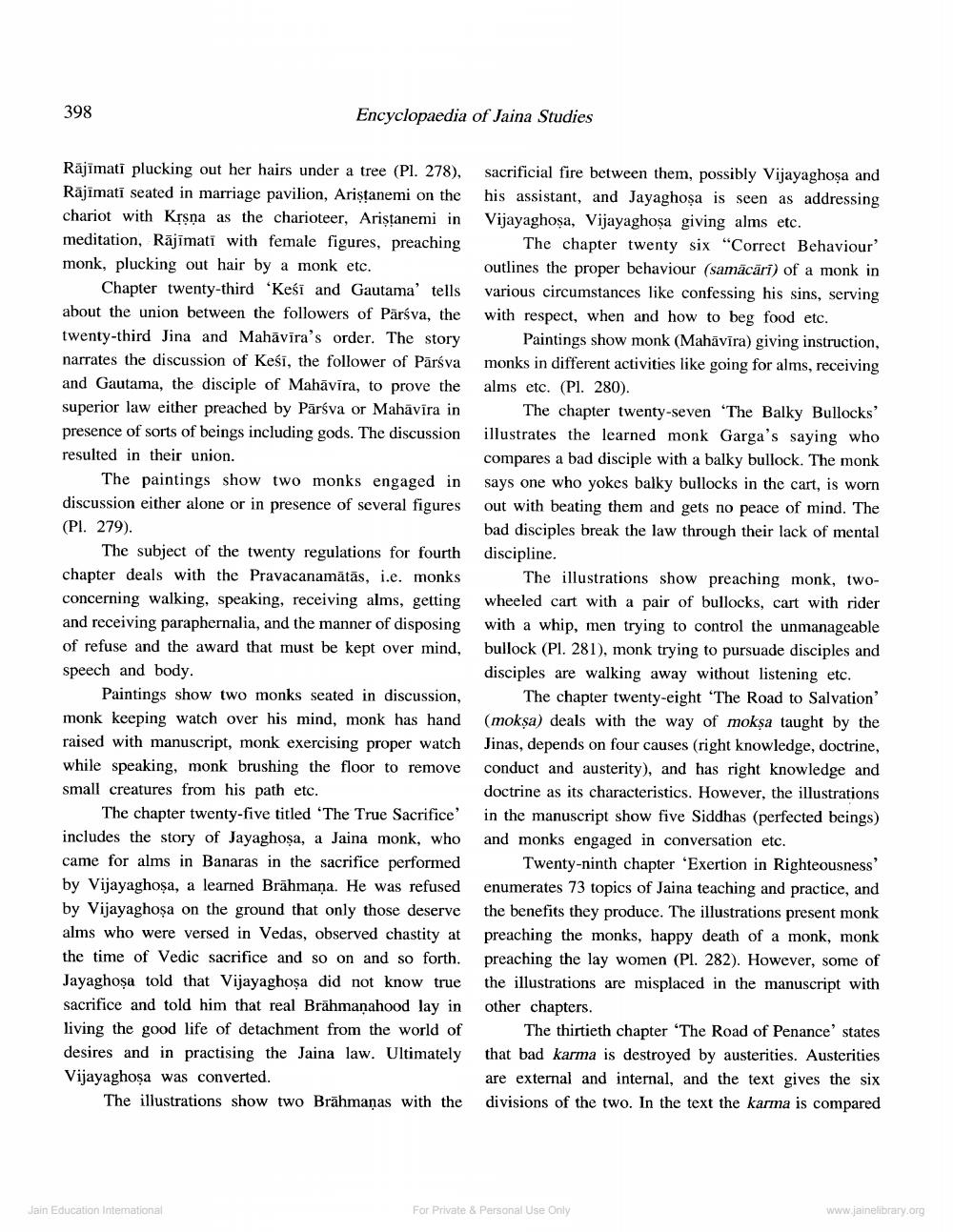________________
398
Encyclopaedia of Jaina Studies
Rājīmati plucking out her hairs under a tree (Pl. 278), Räjimati seated in marriage pavilion, Aristanemi on the chariot with Krsņa as the charioteer, Aristanemi in meditation, Rājīmati with female figures, preaching monk, plucking out hair by a monk etc.
Chapter twenty-third 'Kesi and Gautama' tells about the union between the followers of Pärśva, the twenty-third Jina and Mahāvīra's order. The story narrates the discussion of Kesi, the follower of Parsva and Gautama, the disciple of Mahāvīra, to prove the superior law either preached by Pārsva or Mahävira in presence of sorts of beings including gods. The discussion resulted in their union.
The paintings show two monks engaged in discussion either alone or in presence of several figures (Pl. 279).
The subject of the twenty regulations for fourth chapter deals with the Pravacanamātās, i.e. monks concerning walking, speaking, receiving alms, getting and receiving paraphernalia, and the manner of disposing of refuse and the award that must be kept over mind, speech and body.
Paintings show two monks seated in discussion, monk keeping watch over his mind, monk has hand raised with manuscript, monk exercising proper watch while speaking, monk brushing the floor to remove small creatures from his path etc.
The chapter twenty-five titled 'The True Sacrifice' includes the story of Jayaghoșa, a Jaina monk, who came for alms in Banaras in the sacrifice performed by Vijayaghoșa, a learned Brāhmaṇa. He was refused by Vijayaghosa on the ground that only those deserve alms who were versed in Vedas, observed chastity at the time of Vedic sacrifice and so on and so forth. Jayaghoşa told that Vijayaghosa did not know true sacrifice and told him that real Brāhmaṇahood lay in living the good life of detachment from the world of desires and in practising the Jaina law. Ultimately Vijayaghosa was converted.
The illustrations show two Brāhmaṇas with the
sacrificial fire between them, possibly Vijayaghoșa and his assistant, and Jayaghoṣa is seen as addressing Vijayaghosa, Vijayaghoşa giving alms etc.
The chapter twenty six "Correct Behaviour' outlines the proper behaviour (samācāri) of a monk in various circumstances like confessing his sins, serving with respect, when and how to beg food etc.
Paintings show monk (Mahavira) giving instruction, monks in different activities like going for alms, receiving alms etc. (Pl. 280).
The chapter twenty-seven 'The Balky Bullocks' illustrates the learned monk Garga's saying who compares a bad disciple with a balky bullock. The monk says one who yokes balky bullocks in the cart, is worn out with beating them and gets no peace of mind. The bad disciples break the law through their lack of mental discipline.
The illustrations show preaching monk, twowheeled cart with a pair of bullocks, cart with rider with a whip, men trying to control the unmanageable bullock (Pl. 281), monk trying to pursuade disciples and disciples are walking away without listening etc.
The chapter twenty-eight 'The Road to Salvation' (mokşa) deals with the way of moksa taught by the Jinas, depends on four causes (right knowledge, doctrine, conduct and austerity), and has right knowledge and doctrine as its characteristics. However, the illustrations in the manuscript show five Siddhas (perfected beings) and monks engaged in conversation etc.
Twenty-ninth chapter 'Exertion in Righteousness' enumerates 73 topics of Jaina teaching and practice, and the benefits they produce. The illustrations present monk preaching the monks, happy death of a monk, monk preaching the lay women (Pl. 282). However, some of the illustrations are misplaced in the manuscript with other chapters.
The thirtieth chapter 'The Road of Penance' states that bad karma is destroyed by austerities. Austerities are external and internal, and the text gives the six divisions of the two. In the text the karma is compared
Jain Education International
www.jainelibrary.org
For Private & Personal Use Only
Education International
For Private & Personal Use Only




